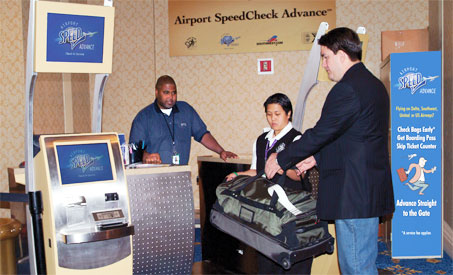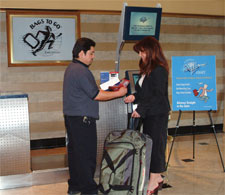
Las Vegas McCarran International airport led the way for check-in at off-site airport locations three years ago and today uses RFID to track passengers’ bags from five remote locations: three hotels, a convention center and car rental facility. The US has long-established check-in practices from an off-airport location, where passengers have been open to paying a convenience fee to check-in, have their bags dropped off and their boarding passes hand-delivered – processes which fast-track them to the departure gate and avoid queues at the ticket counter. The Transportation Security Administration (TSA) fully regulates the transfer of bags from their point of origin, through to the screening process and loading onto the flight. “Off-site check-in drives efficiencies – the more that we can decongest the airport, the more efficient it is,” said Samuel Ingalls, assistant director of aviation, Information Systems, Las Vegas McCarran. “It represents a de facto expansion of the airport itself and it’s taking the airport to the passenger. Things have become so extended and virtualized that we are going beyond the airport boundaries. It also enhances our overall airport capacity, rather than having to expand our brick and mortar facilities.”
Leisure travelers who check-in remotely are inevitably helping airports with revenue gains on non-aeronauticals because they aren’t standing in a queue, said Ingalls. “If passengers are waiting to check-in, airports certainly are not gaining.”
Airlines signing up to the service across the US have grown markedly – including Continental, Delta, United and American Airlines, as well as low-cost airlines JetBlue and AirTran. Southwest will offer remote check-in from June.
American Airlines, which offers a remote ‘Advanced bag check’ service to 20 US airports, is growing to serve its customers from convention centers – a move that will further drive cost savings, explained Roy Braganza, senior manager of remote check-in, American Airlines. “We have essentially taken the skycap operation of curbside check-in and put it into a remote site. Taking the service to hotels started late last year and we have used our cruise ship model to check-in large volumes of people so that people in convention centers can now be checked-in. This doesn’t present any cost to the airline, unlike curbside check-in,” he said.
By allowing more passengers to utilize the service in remote areas, the airport’s traditional landside infrastructure will change, he said. “When you see you are handling 20% of bags remotely, the ticket counters will shrink. The airports see a benefit here – checking-in away from the airports is better.”
Orlando-based Bags (Baggage Airline Guest Services), provider of remote skycap services in the US, is looking to expand the scope of its service to cruise ships traveling to Europe. “We are in discussions with a number of European airlines, including SAS in Copenhagen and Virgin Atlantic,” said Craig Mateer, CEO, Bags.
International focus

“What we have done and allows us to be successful is to expand our infrastructure so there is a volume of passengers to serve. Our expectation is to grow in Europe at a minimum – to Copenhagen, Barcelona and London this year. We need to operate for multiple airlines for this service to work. My expectation is that we will move quickly in Europe – we have learned how to do this in the US,” said Mateer.
Braganza also discussed proposals for a remote check-in service at a New York train station, as well as London Heathrow airport and Barcelona, across hotels and cruise ships for American Airlines customers.
While technology has now made it possible to set up a remote check-in application anywhere with an internet connection, the cruise ship model is playing an important role in driving growth, enabling a remote check-in program to be added wherever the cruise ship travels to. Extending the reach of the airport to check-in points at the train stations is also being considered. Five Airport Express stations in Hong Kong already offer the service from a convenient in-town check-in desk.
Ingalls foresees the possibility of the remote check-in trend catching on in more localized areas. “I think it will continue to grow significantly. The traveler could go and have dinner and then check-in for their flight. There is a benefit to the host and of the check-in environment – people will spend more money on their property, so you can spread the benefits out.”
In the short-term, the reality will be a processing of larger passenger groups – supported by a hotel or convention facility that is hosting the off-site check-in location. As checking-in from remote locations continues to grow, airports will be looking to downsize and converting that space to be of some benefit to them, said Braganza.
Dave Tomber, manager, strategic facility planning, Seattle airport, concedes that as check-in practices are changing, remote check-in will not only ease congestion, but could help to drive new terminal configurations. “It may not be the case in future that we need to build two levels of the same footprint – of the arrivals hall and check-in desk. The arrivals hall could be the major identity for the terminal, so there will be a smaller footprint – perhaps from two levels to one,” he said. “Dispersing activity away from the airport is a challenge but also a great opportunity. If you can conduct part of the process away from the ticketing lobby, that is a better way to manage capacity.”







